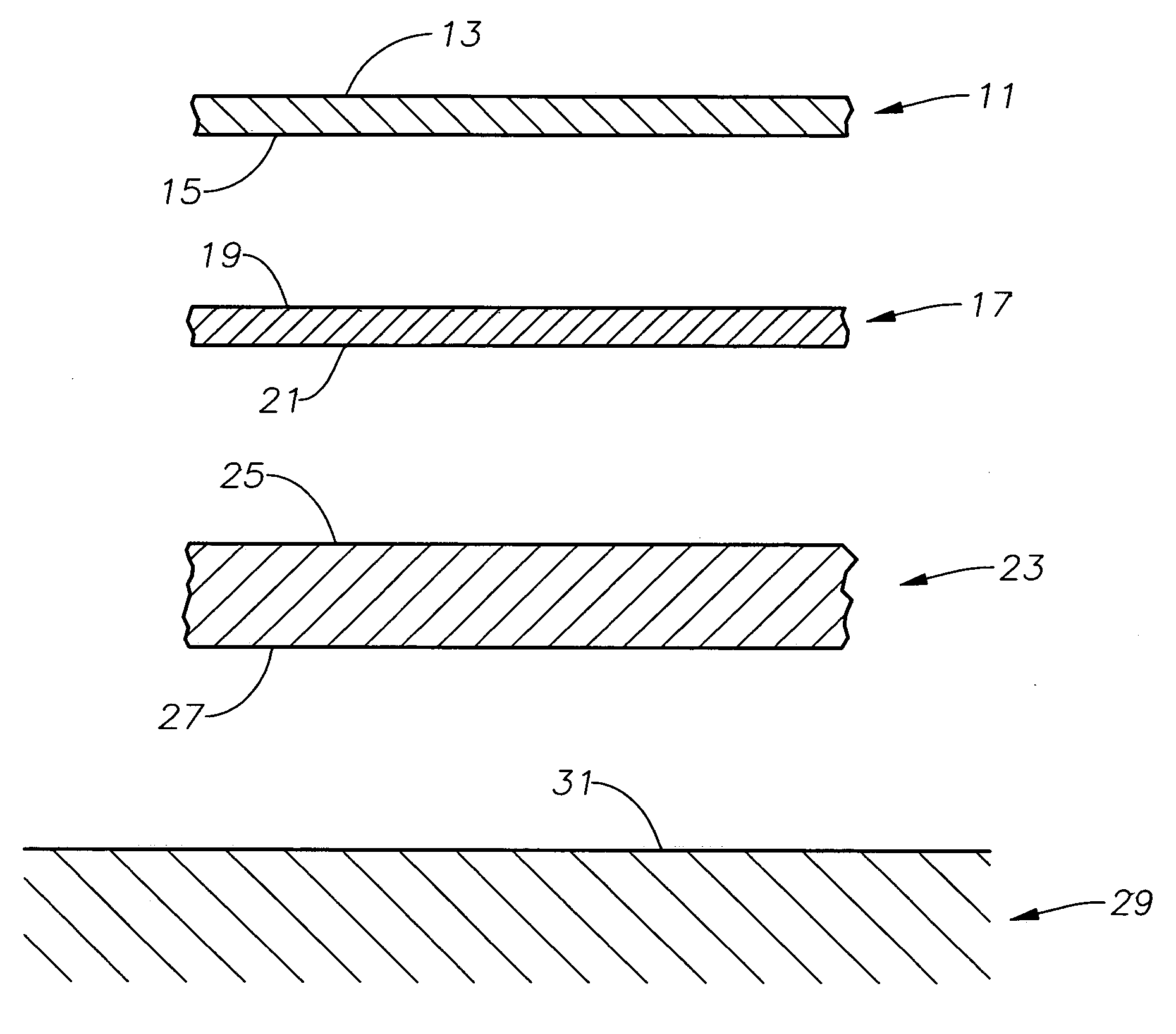Composite roofing and methods of producing composite roofing
a composite roofing and composite structure technology, applied in the field of composite structure and method of producing composite roofing, can solve the problems of poor peel strength, poor adhesive properties of adhesive compositions, and degradation of seam performance at elevated temperatures
- Summary
- Abstract
- Description
- Claims
- Application Information
AI Technical Summary
Problems solved by technology
Method used
Image
Examples
example 1
[0050]1.1—A 1.5 m wide by 0.20 mm thick roll of thermoplastic elastomer film was extruded from pellets of Santoprene 8291-80TB, on a 76 mm extruder operated per processing parameters for thermoplastic vulcanizates known in the art. The extruder was fitted with a 1.5 m wide sheet die to produce the film. Prior to extrusion processing, the Santoprene 8291-80TB material was dried at 70° C. for 4 hours in a dehumidified dryer.
[0051]1.2—Insulation panels, of ACFOAMII, comprising 5 cm thick×1.2 m wide×2.4 m long, made of rigid polyisocyanurate foam with laminated insulations facer material on each side were obtained from the manufacturer of the product, Atlas Roofing Corporation. The insulation facer material consisted of a heavy, paper-like, cellulostic and chopped strand fiberglass material, which is common to polyisocyanurate foam insulations used in the commercial roofing industry. The roof insulation panels were identical on both sides; therefore there was no top or bottom.
[0052]1.3—...
example 2
[0082]2.1—A rigid foam insulation panel, with a thermoplastic elastomer coated insulation facer was created by obtaining a roll of ACFOAMII insulation facer material from Atlas Roofing Corporation, and extrusion coating the insulation facer material by Rowmark, Inc. with Santoprene 8291-80TB thermoplastic elastomer. Subsequently, Atlas Roofing Corp. manufactured insulation panels with the thermoplastic elastomer coated insulation facer composite, per Atlas proprietary process for applying roof insulation facer to their polyisocyanurate foam insulation, to produce 5 cm thick×1.2 m wide×2.4 m long insulation panels.
[0083]2.2—A roofing composite, using the above described composite thermoplastic elastomer coated insulation facer foam insulation panel, was created at Trufast Corporation. Trufast is a manufacturer of fastening systems for commercial roofing, metal building construction, and specialty applications. The purpose of creating the roofing composite at Trufast Corporation was t...
example 3
[0115]3.1—Obtained a 1 meter wide roll of Texbond R 120, a 120 g / m2 nonwoven matting from Freudenberg Texbond LP. Texbond R, per its MSDS, is made of recycled & virgin polyester, with a binder of vinyl-acrylic, styrene-acrylic, melamine and / or ureic resin. This material could be used as an insulation facer and / or component of a roofing composite.
[0116]3.2—A 1.5 m wide by 0.20 mm thick roll of thermoplastic elastomer film was extruded from pellets of Santoprene 8291-80TB, on a 76 mm extruder operated per typical processing parameters for thermoplastic vulcanizates (TPVs). The extruder was fitted with a 1.5 meter wide sheet die to produce the film. Prior to extrusion processing, the Santoprene 8291-80TB material was dried at 70° C. for 4 hours in a dehumidified dryer.
[0117]3.3—The first stage of creating the roofing composite involved creating a laminated composite by dry heat, to chemically and mechanically bond the Santoprene 8291-80TB thermoplastic elastomer to the Texbond R 120 no...
PUM
| Property | Measurement | Unit |
|---|---|---|
| melting point | aaaaa | aaaaa |
| widths | aaaaa | aaaaa |
| wt % | aaaaa | aaaaa |
Abstract
Description
Claims
Application Information
 Login to View More
Login to View More - R&D
- Intellectual Property
- Life Sciences
- Materials
- Tech Scout
- Unparalleled Data Quality
- Higher Quality Content
- 60% Fewer Hallucinations
Browse by: Latest US Patents, China's latest patents, Technical Efficacy Thesaurus, Application Domain, Technology Topic, Popular Technical Reports.
© 2025 PatSnap. All rights reserved.Legal|Privacy policy|Modern Slavery Act Transparency Statement|Sitemap|About US| Contact US: help@patsnap.com


